P2479
Market Lamb Project Guide: Show Lamb Selection and Development
Market Lamb Selection
Market lambs provide an excellent project for 4-H youth to learn about being responsible for animals. Along the way, they learn more about the sheep industry and agriculture in general. The market lamb project teaches how to own and work with lambs; how to take responsibility for lambs’ health, care, and growth; and how to win or lose competitions gracefully. These are important life lessons that will serve a 4-H’er even as an adult.
Breeds of Sheep
There are several breeds exhibited at the junior market lamb shows in Mississippi. They include Dorset, Hamphsire, Oxford, Shropshire, Suffolk, and Crossbreds. There is also a new market hair sheep show. Katahdin and Dorper are the most common of the hair sheep breeds exhibited in our shows. There is also a wether dam show that allows wool and hair sheep to compete in a ewe show. For all these shows, lambs are shown strictly by declared show weight.
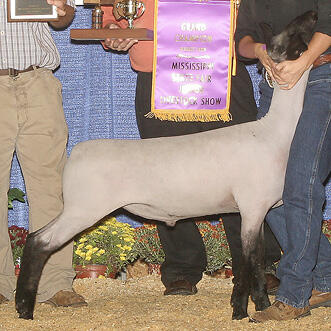
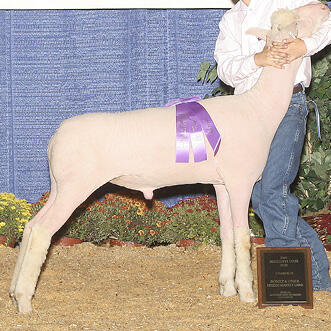
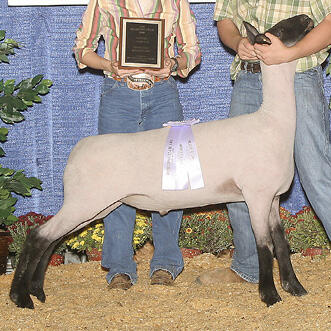
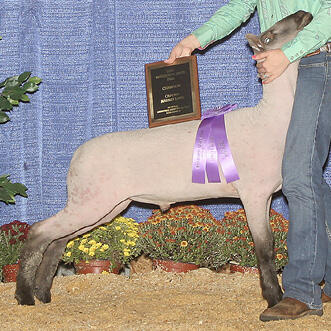
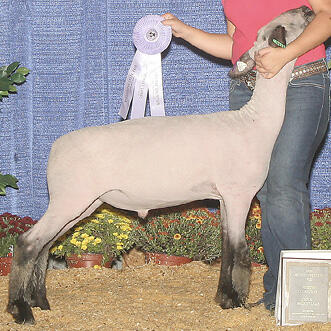
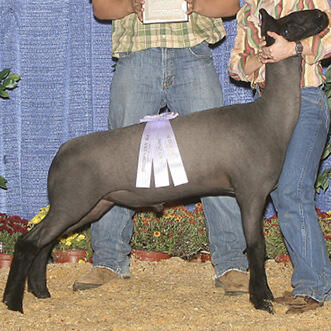
NOTE: Photos courtesy of Lowery and Sumrall Photography taken at the 2006 Mississippi State Fair.
Parts of the Sheep
Before selecting a lamb for a 4-H project, it is important to have a good understanding of the parts of the sheep.

1. face
2. forehead
3. poll
4. neck
5. breast
6. top of shoulder
7. shoulder
8. point of shoulder
9. elbow
10. forearm
11. knee
12. cannon
13. dewclaw
14. foot
15. forerib
16. lower forerib
17. rib
18. back or top
19. middle
20. rear flank
21. loin
22. hip
23. rump
24. dock
25. leg
26. hock
27. pastern
Diagram taken from MSU Extension Publication 2289 Mississippi 4-H Livestock Judging Manual.
Criteria Used for Selection of Market Lambs
When selecting the ideal market lamb, pay attention to muscle, length of body, structural correctness, and style/balance.
Muscle
Lambs shown in junior livestock shows should have good muscling. Specifically, the lamb should have firm, hard muscling in the loin, rump, and legs, which are the higher priced cuts of a lamb carcass. Muscle expression should be visible from the front, side, and rear.
From the front of the lamb, look for muscle from the knee to shoulder. In young lambs, a good indicator of muscling from the front view is the circumference of the cannon bone. A prominent shoulder is good, but a shoulder that is too large will take away from a smooth, balanced appearance.
The widest point visible from the rear should be through the center of the leg or stifle area. The ideal lamb has a large and expressive muscle around the leg, just above the stifle joint. Another signal that the lamb has good muscling is a wide stance and stride, which can be a sign of extensive muscling on the inside of the leg. But a lamb can also have a wide stance because of its skeletal structure, so be sure to check the inside of the leg to see if the wide stance is a result of structure or muscle.
In addition to being wide through the leg, the lamb should be wide across the top, a sign of loin muscle. To determine if the loin is large and muscular, feel down the back bone of the lamb. If you can feel a groove down the top of a young lamb, it probably has good muscling.
Length of Body
When selecting a market lamb, choose a well-proportioned animal based on the legs, loin, and rump. A lamb that is too long may have a weak top. Shorter-bodied, compactly built lambs are also undesirable. An ideal lamb is longer through the loin and rump, or hind saddle, than it is through the rack. The rack is measured from the point of the shoulder to the last rib. The length of the hind saddle is the distance from the last two ribs to the pin bones. This distance should be 2 or more inches longer than the rack and varies depending on the size of the lamb.
Structural Correctness
Market lambs should have correct structure and good bone structure. Powerful lambs will stand on a large circumference of bone. While standing, a lamb should be wide through the chest with its feet and legs apart. Those lambs that are open-shouldered and weaker-topped are likely to have less muscling than are other lambs. On the move, lambs should track wide with a long, smooth stride. The neck of the lamb should extend out the top of the shoulder and be tall and erect. A long, level top line is also desirable. Sloping off at the rump is an indication of less muscling.
Style/Balance
These terms describe how the front and rear of the lamb should fit together. A healthy-looking lamb has a clean, trim chest and no excessive weight or condition. A desirable lamb is extended through the front end and has a long, lean neck. Its shoulders are smooth and not too prominent, and it has a smooth neck-to-shoulder junction. An ideal lamb has a level, long, smooth muscle along its top. Look for a lamb with a trim breast that appears to be an easy fleshing lamb.
When viewing a group of lambs in a pen, the most noticeable lamb should be attractive to you. It may have a fresh appearance (trim and clean patterned) with more future growth potential than other lambs. This can be determined by how the lamb carries itself, with a long, powerful stride and good expression of muscle.
Final Thoughts on Lamb Selection
Selecting market lambs is based on potential. Evaluate groups of lambs to find a large-framed, long-bodied lamb with good muscle expression and growth potential. It is important to look for a level-topped lamb with a wide and thick loin that is level through the rump. With proper nutrition and hard work on your part, these types of lambs have the best potential to become champion lambs. Be sure to get a bill of sale from the producer. If you purchase the lamb out of state, follow proper procedures to bring the lamb back to Mississippi.
Equipment Needed for Showing Your Lamb
To make your lamb the best that it can be, keep the proper equipment on hand, both at home and at the show. This equipment should include a stiff brush for cleaning feed and water troughs, shovel, rake, trimming table, clippers, rope halter, hand shears, portable feed and water troughs to take to shows, and lamb blankets or socks. If you are concerned about your lamb escaping from its pen at home or at the show, get a muzzle to prevent the lamb from overeating if it escapes. You can use a net to feed hay with less mess and keep the lamb from eating other materials. Clip lambs with clippers and shears during hot weather to keep them cooler and more comfortable. Be sure that lambs have access to shade to prevent sunburn.
Exercise Plan for Lambs
An exercise program for market lambs is important for several reasons. Exercise increases muscle development and appetite. It helps to increase condition (feel to muscle) to help properly finish lambs (fat cover).
Depending on the size of the pen, a forced exercise program may not be needed. Too much exercise is not good, but just walking a lamb with a halter is not likely to increase muscle tone. Each lamb has different needs, and you must decide the best type of exercise program for your lamb.
When starting a lamb exercise program, allow the animal to adjust to the program by building the duration and type of exercise. Exercise lambs early in the morning or later in the evening, when it is cooler outside, to avoid overheating. You can use obstacles for the lamb to jump over to develop the leg and loin. Be careful in how these obstacles are used. To avoid injury, do not make the lamb jump several obstacles at one time. Running lambs can firm and harden finish. Again, adapt the exercise program to your lamb. If a lamb is underweight close to the show, exercise may not be the best option for that lamb. However, if a lamb is approaching excess condition, exercise may help firm the finish.
Conclusion
When evaluating a lamb, observe its muscling, length of body, structural correctness, balance, and style. These factors, taken together, are important in an ideal lamb. To help the lamb achieve its full potential, design a proper nutrition and exercise program. This program can allow the lamb to reach its optimal weight and condition by show time and may lead to success in the show ring.
Publication 2479 (POD-10-20)
By Dean Jousan, Associate Extension Professor, Animal and Dairy Sciences, and Roy Higdon, Area Extension Agent (retired).
